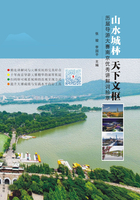
Qinhuai River

赛项:2014年第四届南京市导游大赛
选手:夏影(一等奖)
选送:中山陵园管理局
Hello, ladies and gentlemen, I am Xia Ying, you can call me Joynes; and I hope you will enjoy the cruise on this pleasure boat.
Now the bridge over our head is Wende Bridge. There is a famous legend goes like this: at midnight on the 15th of the 11th lunar month, the bridge is flanked by half of the moon.
Now, the architecture on our left hand side, is the “All Scholars Gateway” which refers to Confucius as the hub of all articles and morality.
What you can see now on your right hand is a screen wall. It has a length of 110 meters, which is the longest of its kind in China! The function is to indicate Confucius' learning is too profound to be understood by common people.
Now, please look at the left side, this is Kuixing Pavilion which has 3 levels. It was used for sacrificing the God of Literature who controlled our literary fate. It was also the symbol of winning the first prize in the imperial examination.

秦淮河
Well, the Confucius temple was first built about 1,000 years ago, in the Northern Song Dynasty and rebuilt in 1986. The river flows through it is called the inner Qinhuai River. What's the meaning of “inner”?
Actually, when Qinhuai River reaches the city, it is divided into 2 streams. The one goes around the city walls is the outer Qinhuai River and the other one goes into the city is the inner Qinhuai River. The inner one is used to be a very important transport of grain and salt. So there were many restaurants and tea houses on both banks just because of its prosperity.
Now, please look forward. This is the Wenyuan Bridge, which means the source of articles.
And the area on our left hand side is Jiangnan Imperial Examination Center, where the imperial exams were held. The examination was the basic system for selecting officials in feudal China. It was initiated in the Sui Dynasty and established in the Tang Dynasty. Then flourished in the Ming and Qing Dynasties and finally, abolished in 1905. Wow, a history of more than 1300 years.
The origin of the center can date back to the year of 1169. After several extensions, it was developed into the largest one in the Ming and Qing Dynasties. During that period, the students of about 23 provinces needed to take the exams here.
The selecting system was very strict and complex. There were all together 4 levels, the county, provincial, national and palace examinations. Every candidate should spend nine days in a very small private room, and had no freedom to leave until the exam was over.
How hard it was? Only 1 out of the 100 candidates could pass. Wow, it was too hard! At least for me.
So before the exam, the candidates usually went to the Confucius temple and prayed: “Give me the power! Give me the encouragement,and let me pass the examination.” If he passed the exam, he surely went back to the temple to show his thankfulness.
Now, please look at on your left hand side. This is the Tao Ye Ferry. According to the legend, there was a famous calligrapher called Wang Xianzhi, who loved his wife Tao Ye very much. When Tao Ye boated across here, Wang Xianzhi was always worried about her. Every time, he would accompany Tao Ye to cross the river together. Sounds so romantic, isn't it? This ferry just drives its name from Tao Ye.
Now the area on our right hand is the Egret Islet Park or we can say Bailuzhou Park, which used to be a habitat of many egrets.
Now, please look forward, we can see a gate made of stone at the end of this river. We call it the East Sluice. The East Sluice was built more than 600 years ago in the Ming Dynasty, and Qinhuai River just separates from here. The function of the gate is to adjust the water level of the inner and outer Qinhuai River.
Now, ladies and gentlemen, our boat will return. You can take some photos of these unique architectures. I really wish you enjoy your stay in Nanjing.
Thanks for listening.
关键词点击
秦淮风光带
夫子庙秦淮风光带位于南京市秦淮区,以夫子庙为核心、十里秦淮为轴线、明城墙为纽带,串联起众多全国重点文物保护单位、省级和市级文物保护单位,以儒家思想与科举文化、民俗文化等为内涵,集旅游观光、美食购物、科普教育、节庆文化等功能于一体,是南京历史文化荟萃之地,也是著名的开放式国家5A级旅游景区。
秦淮河是南京古老文明的摇篮,南京的母亲河,历史上极富盛名。这里素为“六朝烟月之区,金粉荟萃之所”,更兼十代繁华之地,“衣冠文物,盛于江南;文采风流,甲于海内”,被称为“中国第一历史文化名河”。
知识拓展
棂星门
“棂星门”是文庙中轴线上的牌楼式木质或石质建筑。“棂星”即灵星,又名天田星。《后汉书》记载,汉高祖祭天祈年,命祀天田星。天田星是二十八宿之一“龙宿”的左角,因为角是天门,门形为窗棂,故而称门为棂星门。皇帝祭天时,要先祭棂星。袁枚在《随园随笔》中说:“后人以汉灵星祈年与孔庙无涉,又见门形为窗灵,遂改为棂。”在宋代,棂星门又称“乌头门”,文庙修棂星门,象征祭孔如同尊天。文庙中的棂星门是在明太祖洪武十五年以后出现的,象征祭孔如同尊天。后来人们又将棂星解释为天镇星、文曲星、魁星。古人认为“天镇星主得士之庆,其精下为灵星之神”,以棂星命名孔庙大门,象征着孔子可与天上施行教化、广育英才的天镇星相比,又意味着天下文人学士汇集于此,统一于儒学的门下。

棂星门